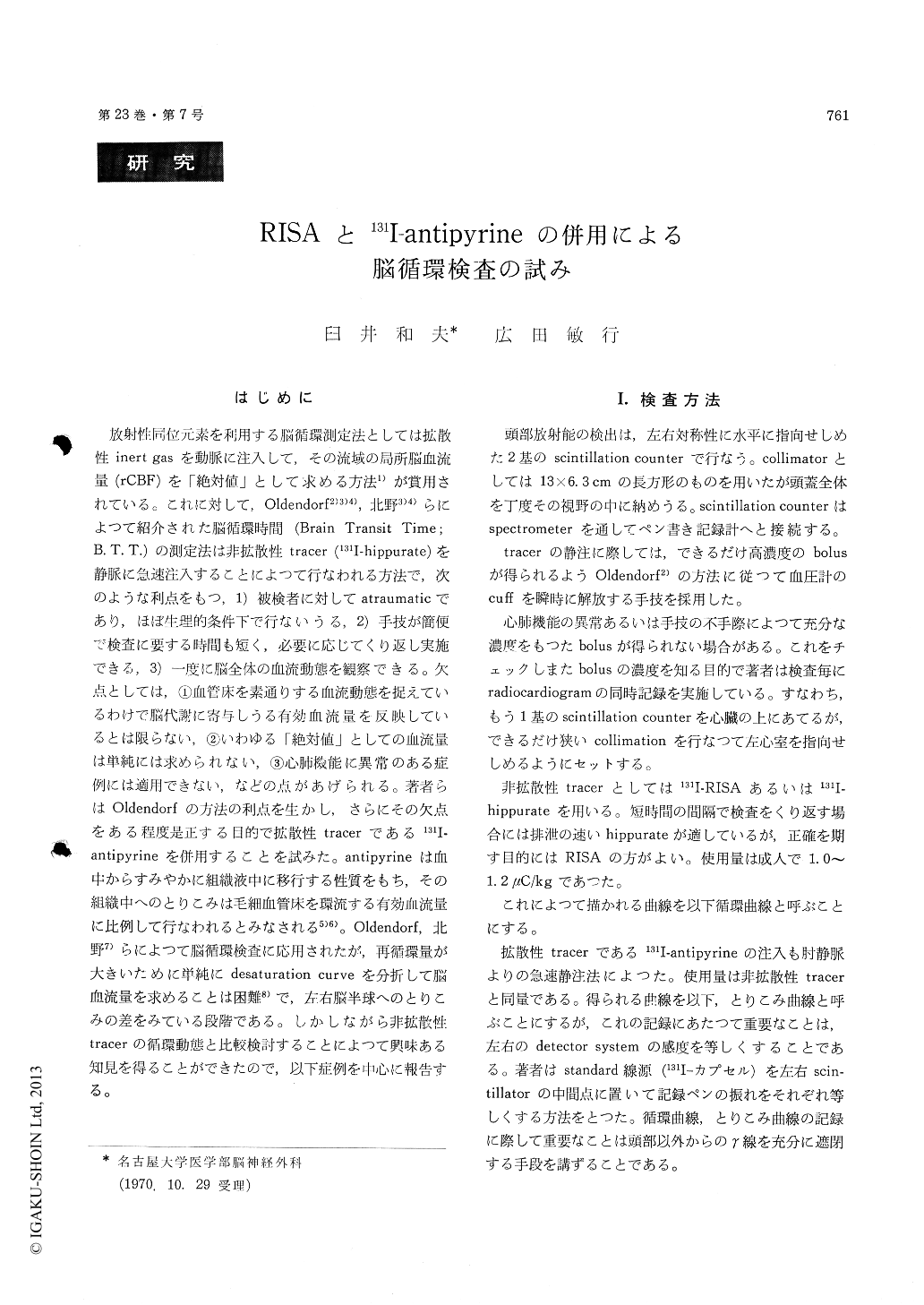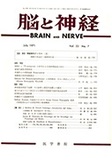Japanese
English
- 有料閲覧
- Abstract 文献概要
- 1ページ目 Look Inside
はじめに
放射性同位元素を利用する脳循環測定法としては拡散性inert gasを動脈に注入して,その流域の局所脳血流量(rCBF)を「絶対値」として求める方法1)が賞用されている。これに対して,Oldendorf2)3)4),北野3)4)らによつて紹介された脳循環時問(Brain Transit Time;B.T.T.)の測定法は非拡散性tracer (131I-hippurate)を静脈に急速注入することによつて行なわれる方法で,次のような利点をもつ,1)被検者に対してatraumaticであり,ほぼ生理的条件下で行ないうる,2)手技が簡便で検査に要する時間も短く,必要に応じてくり返し実施できる,3)一度に脳全体の血流動態を観察できる。欠点としては,①血管床を素通りする血流動態を捉えているわけで脳代謝に寄与しうる有効血流量を反映しているとは限らない,②いわゆる「絶対値」としての血流量は単純には求められない,③心肺機能に異常のある症例には適用できない,などの点があげられる。著者らはOldendorfの方法の利点を生かし,さらにその欠点をある程度是正する目的で拡散性tracerである131I—antipyrineを併用することを試みた。antipyrineは血中からすみやかに組織液中に移行する性質をもち,その組織中へのとりこみは毛細血管床を環流する有効血流量に比例して行なわれるとみなされる5)6)。Oldendorf,北野7)らによつて脳循環検査に応用されたが,再循環量が大きいために単純にdesaturation curveを分折して脳血流量を求めることは困難8)で,左右脳半球へのとりこみの差をみている段階である。しかしながら非拡散性tracerの循環動態と比較検討することによつて興味ある知見を得ることができたので,以下症例を中心に報告する。
A method of a simple, atraumatic and easily re-peatable test of the cerebral circulation was studied by the combined use of a diffusible (131I-antipyrine) and a non-diffusible tracer (RISA), both of which were injected rapidly from the cubital vein.
From a RISA-curve (cerebral circulation curve), the dilution rate of a bolus in the brain was meas-ured as well as brain transit time (B. T. T.). The dilution rate of a bolus was calculated as a ratio between the maximal concentration of a bolus and that of the tracer in the brain. The former was obtained from the radiocardiogram recorded simul-taneously.
Values in normals were as follows ; B. T. T.: 7. 9± 1. 1 sec (R), 8. 6 ± 1. 0 sec L). Dilution rate of a bolus ; 0. 75 ± 0. 11 (R), 0. 73 ± 0. 09 (L).
From an antipyrine-uptake curve, the difference of the capillary blood flow between both hemispheres is eventually known. The differences of the uptake in normals were within 5%.
Following cases were presented and discussed.
Case 1 : Unilateral brain atrophy (shistosomiasis) showed prolongation of B. T. T. and marked decrease in antipyrine uptake on the affected side.
Case 2: A postoperative case of an aneurysm of the anterior cerebral artery. Prolongation of B. T. T and decreased uptake on the operated side.
Case 3: An infraclinoid aneurysm of the left internal carotid artery. Decrease in C. B. F. was observed after the carotid ligation.
Case 4: A huge arteriovenous malformation. De-cereased C. B. F. in A-V malformation was concluded after the artificial embolization.
Case 5: Complete normal results were obtained in spite of a large aneurysm of the right middle cerebral artery.
Case 6: Aortic arch syndrome (bilateral carotid obstruction). No gross abnormality was found in the study.

Copyright © 1971, Igaku-Shoin Ltd. All rights reserved.


